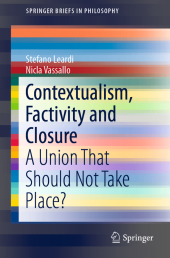 Neuerscheinungen 2019Stand: 2020-02-01 |
Schnellsuche
ISBN/Stichwort/Autor
|
Herderstraße 10
10625 Berlin
Tel.: 030 315 714 16
Fax 030 315 714 14
info@buchspektrum.de |

Stefano Leardi, Nicla Vassallo
(Beteiligte)
Contextualism, Factivity and Closure
A Union That Should Not Take Place?
1st ed. 2018. 2019. xii, 94 S. 1 SW-Abb. 235 mm
Verlag/Jahr: SPRINGER, BERLIN; SPRINGER INTERNATIONAL PUBLISHING 2019
ISBN: 3-03-016154-4 (3030161544)
Neue ISBN: 978-3-03-016154-5 (9783030161545)
Preis und Lieferzeit: Bitte klicken
This book analyses an inconsistency within epistemic contextualism known as the factivity problem. It also provides key insights into epistemic contextualism, an important innovation in contemporary epistemology, enabling readers to gain a better understanding of the various solutions to the factivity problem. As the authors demonstrate, each explanation is based on a different interpretation of the problem.
Divided into seven chapters, the book offers comprehensive coverage of this topic, which will be of major interest to philosophers engaged in epistemology and the philosophy of language. After an introductory chapter, Chapter 2 presents the most common understanding of epistemic contextualism and its semantic basis. It also clarifies the epistemological implications of the theory´s semantic assumptions. This chapter also explains the main argument of the factivity problem.
The next four chapters discuss the respective solutions proposed by Wolfgang Freitag, Alexander Dinges, Anthony Brueckner and Christopher Buford, Michael Ashfield, Martin Montminy and Wes Skolits, and Peter Baumann. Stefano Leardi and Nicla Vassallo highlight the similarities and commonalities, identifying three main approaches to the factivity problem.
Chapter 7 provides a brief overview of the solutions proposed to solve the factivity problem and presents an outline of the conclusions reached in the book.
1. Introduction.- 2. Is Epistemic Contextualism an Inconsistent Theory?.- 3. Solving the Factivity Problem.- 4. Two Promising Approaches.- 5. Conclusions.


